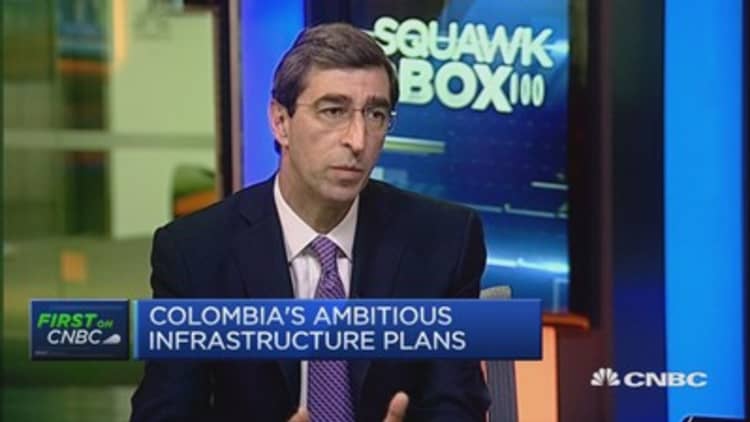The scope of worry for emerging market (EM) investors just got wider, as Colombia and Peru become the latest entrants to the pool of troublesome markets.
Colombia was ranked the emerging market most vulnerable to higher U.S. interest rates , fresh data from BNP Paribas has shown, followed by Turkey and Peru. The South American countries eclipsed more traditional threats to an EM investor's portfolio such as Brazil and South Africa.
The Federal Reserve could fire its first interest rate hike in nearly a decade later this year, according to widespread estimates. The first mention of a rate hike back in 2013 triggered 20 percent currency declines for emerging heavyweights like India and Indonesia, so investors are racing to position their portfolios properly this time around.
Commodity exposure is key
High exposure to volatile commodity prices makes the South American "dark horse economies" poster children for vulnerability to a Fed rate rise, BNP said in a report last week.
Global commodity prices tend to be inversely correlated with the U.S. dollar, so with the greenback set to rise as the Fed begins to raise rates, that can be a source of contagion for commodity-exporting emerging markets. The bank offered a trail of negative consequences arising from a stronger dollar and lower commodity prices: export revenues decline, hurting the current account; and foreign direct investment (FDI) into the resource sector drops, exacerbating reliance on hot money flows.
Bogota depends on oil for around 20 percent of its revenue, and a 44 percent slide in Brent crude prices over the past year has left the country with a current account deficit representing nearly 6 percent of gross domestic product (GDP). More pain is coming, with 2015 oil revenues expected to tumble 60 percent from two years ago, finance minister Mauricio Cardenas said last month.

Colombia will also require larger external financing in the near term since any adjustment in the current account will be small without an oil price rebound, warned Fernando J. Losada, senior economist at AllianceBerstein (AB). "With global interest rates expected to increase once the Fed makes its first move, this larger amount of foreign financing must be monitored closely ," he said.
Meanwhile, exports of copper, gold and zinc account for over 50 percent of Lima's total goods exports and lower metals prices due to weak Chinese demand has resulted in a deficit standing at 4.2 percent of GDP.
"In addition, a weak outlook for the country's mining sector will temper foreign investment, which will reduce the size of financial account surpluses, driving a slower pace of reserves accumulation in the coming years," BMI Research said in a recent note.
Moreover, Peru is reliant on loose monetary policy to boost growth and support the private sector but its central bank could be forced change course when the Fed does hike, warned Bank of America Merrill Lynch (BofAML).
"The economy's high dollarization inhibits the role of the FX as a shock absorber. The Central Reserve Bank of Peru (BCRP) then has to sell reserves to keep the nuevo sol under control...The risk is that when Fed hikes, BCRP will be forced to hike to increase the cost-of-carry of being short sol," the bank explained in a report earlier this month.

